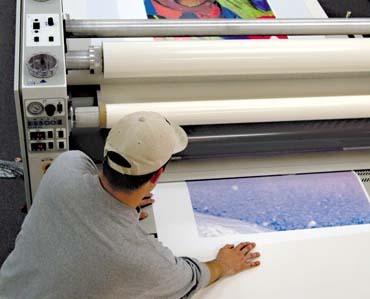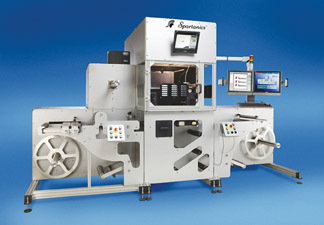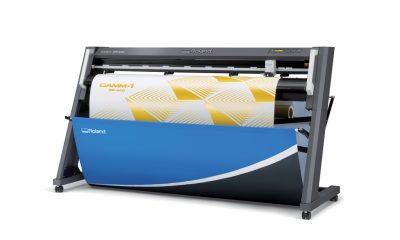Graphics Printing
Published
18 years agoon

What do laminating films have in common with an algebraic expression like 3x + 1 = 10? The process of selecting film is not as finite as the solution to this equation, but the process does involve an "x" factor of its own. When determining what laminating film will best satisfy your needs, you must consider all the variables. But what are the variables? How do you solve for "x"?
What do laminating films have in common with an algebraic expression like 3x + 1 = 10? The process of selecting film is not as finite as the solution to this equation, but the process does involve an "x" factor of its own. When determining what laminating film will best satisfy your needs, you must consider all the variables. But what are the variables? How do you solve for "x"?
Before we get out the calculators and No. 2 pencils, it’s important to ask the following question: Why laminate in the first place? The simple answer is to increase your graphic’s longevity and maintain its appearance. But there are other reasons to consider adding a laminating film:
• protection against ultraviolet (UV) light, which cause graphics to fade
• protection against fingerprints, cleaners, oils, etc.
• added color depth and vibrancy
• added rigidity for easy handling
Because screen printers already utilize UV inks, which makes the finished product inherently resistant to the elements, choosing a laminating film may be a whole new equation. But even in screen printing there are those prints that require a little extra protection, such as applications in high-traffic areas that are susceptible to scratching. In addition, many screen printers are expanding their capabilities into large-format digital printing, which often requires the protection of a laminating film.
For any printer—screen, digital or otherwise—it is important to understand the variety of laminating films available and when each type should be used. In this article, we will focus on two types of laminating films: pressure sensitive and thermal. Both types are defined by how they are applied, and both have separate considerations that will give printers the look, feel, and durability the job requires.
Laying the groundwork
The first step in figuring out the "x" is a big one: determining what type of laminating equipment is available to you (Figure 1). Does the shop only have cold-roll laminating equipment, appropriate for pressure-sensitive films? Or does the laminator also have the ability to heat the rolls to 250°F, necessary for thermal-film application? Establishing this immediately narrows the laminating options to just pressure sensitive or to both pressure sensitive and thermal.
Here are a few questions a graphic supplier should ask to help in product selection:
• What type of equipment do you have?
• What is the output size of your equipment?
• How will you be printing the graphic? (i.e., screen printing, inkjet, solvent-based, etc.)
• What does your customer expect, want, and really need?
• In what environment will the graphic be applied, including weather conditions, lighting, and to what substrate?
• How long would you like the graphic to last?
Let’s not forget the most important question: How much is cost a factor? Often, the key to selecting the proper film is finding the best balance between material properties and cost.
Universal variables
For anyone considering lamination—regardless of whether it will be thermal encapsulation or pressure sensitive—a set of universal variables must be considered. Examining these variables will give the graphics supplier a jumping off point for making the best recommendation on film type to use.
Adhesive While the adhesive type will differ between thermal films and pressure-sensitive laminating materials, the principles behind selection are the same for both. Utilizing the clearest adhesive that your customer’s budget will allow can greatly affect the aesthetics of the graphic. And the higher the profile of the graphic, the more important the clarity of the adhesive becomes. For instance, museums often leave displays in place for long periods of time, and they want the display to be just as pleasing the last day as it was the first. They may select the clearest adhesive available.
Durability The durability of the graphic is directly related to the environment in which it is installed (e.g., indoor vs. outdoor, wall graphic or floor graphic, exposure to moisture/lighting/temperature/traffic). These conditions affect the durability of a film and ultimately the appearance of the graphic. With this in mind, manufacturers create different qualities of films to help you maintain the proper balance of cost vs. function. For example, premium-quality films, which incorporate additives like UV stabilizers; higher quality, longer lasting face stocks; and more technically engineered adhesive systems and are used for more demanding environmental conditions, naturally cost more.
Ease of use All other factors lose their importance when the laminating film is not easy to use. Choosing the right film should make your job easier, not more difficult and time consuming. For all graphics, thickness of the laminating film plays a large role in the degree of conformability or rigidity necessary for the application. The thicker the film, the more rigid it is and the easier it is to work with when the graphic needs to lay flat and stay that way. The thinner the film, the more conformable the graphic will be in uneven or curved displays.
Finish As mentioned earlier, the clarity and uniformity of the adhesive play an active role in the finished graphic. However, varying levels of glossiness on the film must be considered in regard to the lighting in the environment where the graphic will be used. For example, a high-gloss film in a brightly lit room will cause glare, ultimately taking away from the graphic’s appearance rather than adding to it. With floor graphics, choosing a finish with slip-resistance qualities is extremely important for public safety.
Public safety Speaking of public safety, this should be everyone’s responsibility—including laminating-film suppliers and printers. If a fire were to break out, the graphic should not serve as extra fuel for the fire. Be sure to know the national and regional building codes that apply to your application as it pertains to flame-resistance standards for laminating films used in public areas such as museums, bars, malls, etc. Films used in public buildings on walls or floors should be compliant with these codes.
Beyond the universal wants and needs associated with laminating films, there are a whole slew of other variables specific to pressure-sensitive films and thermal laminating films.
Pressure-sensitive laminating films
Pressure-sensitive laminating films (a.k.a. cold-roll films) are made up of three components: face stock, adhesive, and liner. The combination of these components affects the cost of the laminating film. Most suppliers offer good, better, and best packages that bring together different combinations of these components to make the selection process as simple as possible.
Let’s get the easy parts out of the way first: the adhesive and liner. The quality of the adhesive is determined by the needs of the customer. Adhesive quality is already factored into the "good/better/best" formula. We’ll start with "good." Simply put, "good" means "good enough" for most customers—the film provides clarity, cleanliness, smoothness, etc. "Good" grade pressure-sensitive laminating films typically are used in digitally produced graphics that are intended for short-term use (three to six months) and for viewing from a distance.
The "better" grade laminating films provide improved durability, cleanliness, smoothness, etc. They are designed for use in closer-viewing applications that require a longer lifespan (six months to one year). Finally, the "best" grade films offer the highest quality UV protection, clean-room quality, and two- to five-year durability.
The liner is instrumental in the performance of pressure-sensitive laminating film during the finishing processes. The smoother the liner, the smoother the adhesive. And the smoother the adhesive, the better the adhesive wets out during application, resulting in a clearer finished graphic. Also, higher quality liners provide improved stability during the laminating process, resulting in more consistent results and faster laminating speeds.
Face stocks are a little trickier as there are several options to consider with varying pros and cons for each.
Vinyl
Vinyl is the most common face stock for pressure-sensitive laminating films because it is relatively inexpensive, has excellent layflat and conformability characteristics, and it is very durable. It is also very easy to change the gloss level of vinyl stock during manufacturing, which further drives cost down. Both cast and calendered vinyls are used for laminating films. The choice of which type to employ depends on the end-use application and the cost the customer is willing to bear.
Common applications and recommended thicknesses for pressure-sensitive vinyl films include the following:
• Vehicle wraps and fleet marking—A cast 2-mil vinyl is recommended for vehicle graphics (Figure 2). The face stock is kept thin to maintain high conformability.
• Point-of-purchase (P-O-P)—The recommended thickness for P-O-P is 3.0-3.5 mil. The thicker material allows for improved image depth and ease of handling on both the laminator and during installation (Figure 3). In addition, this product is typically less costly than other options.
• Floor graphics—A 5-mil matte vinyl provides for short-term floor graphics with good slip resistance and protection against the wear and tear of foot traffic and floor cleaners. (See industry standard ASTM D2047 for more information on static coefficient of friction requirements for floor graphics.)
Polycarbonate Polycarbonate is found in 5-, 10- and 15-mil thicknesses and used where stiffness and durability are the key variables in the finished graphic. Two main applications for this material include the following:
• Trade-show graphics—Typically 10- and 15- mil products are used for the walls and 5-mil is used for the headers where improved flexibility is required for tight curves. The stiffness found in polycarbonate allows trade-show graphics to fit the curve of display frames. The adhesive must also be extremely cohesive (no separation) when the graphic is repeatedly rolled up for shipping. The finish is mostly a textured finish to avoid glare from the bright lighting often found in exhibit halls.
• Floor graphics—Typically 5-mil film is used. This tough, durable film is ideal for graphics requiring longer-term durability in high traffic areas or areas with heavy machinery (Figure 4).
Polyester Polyester is another common facestock for pressure-sensitive laminating films. It also is one of the most expensive. Polyester provides the best clarity and is commonly used for high-end displays found in museums, airports, or anywhere premium graphic quality is essential. However, unlike its counterpart (vinyl), polyester tends to scratch easily and would not necessarily be recommended in places where it will be touched a lot or walked on.
Polypropylene The final face-stock we will discuss is polypropylene, which has a very specific quality that makes it appealing—it provides a "dry-erase" surface for easy marking and erasing. This film is often used on menu boards and courtroom graphics to temporarily mark crime-scene photos or maps.
Thermal laminating films
Thermal laminating films offer you many of the same qualities as pressure-sensitive films (i.e., protection against UV light, glare, fingerprints, oils), while adding rigidity, depth, and color vibrancy. However, the method by which the film is applied and the construction of the films differ.
Up front, thermal films seem less expensive because they do not require a liner. The downside is that laminating equipment for applying these films is more expensive because thermal films require laminators that provide heat of up to 250°F or more in order to activate the adhesive during the laminating process.
Essentially, thermal films are made up of two parts: the facestock (most of-ten polyester) and the low-melt adhesive. The construction of this type of film is usually described using a ratio of polyester to adhesive. For instance, a 3-mil film may be described as 1:2, meaning 1-mil polyester to 2-mil adhesive.
Thermal laminating films are a little more difficult to work with than pressure-sensitive films. Users of ther-mal films have to balance a number of factors during the application process. For example, the addition of heat, combined with two already existing variables, tension and pressure, increases the potential for user error. Beyond this, improper tension control is one of the biggest causes for error. Many laminator operators run the films through laminators under excessively high tension levels, resulting in curl, boat-waking (machine-direction lines running at a slight angle away from the nip roller), or other strange phenomena. When it comes to tension control, always remember: Less is better.
That’s not to say perfecting this balance isn’t possible. Many laminator operators who use this method of laminating are able to hone their process over time and ultimately have very few errors.
It is also worthwhile to note that, in general, pressure-sensitive laminating films tend to be more expensive than thermal films upfront. But pressure-sensitive films do not require heat for application, nor do they require encapsulation (thermal films must be applied to both sides of a graphic, not just one.). These factors can make pressure-sensitive films a less expensive choice overall.
Applying the knowledge
Now that you’ve seen the types of laminating films available, you should be able to solve for your "x" factor. It’s true that all of these variables can get a little confusing and overwhelming, so the right answer may not be immediately clear. The good news is that there are people out there who know the materials and processes so well that you easily can find some help to get answers. Your suppliers will be glad to assist, so don’t be afraid to ask.
About the author
Jeff Stadelman is the technical marketing manager for MACtac Graphic Products in Stow, Ohio. MACtac is a manufacturer of graphic films and other pressure-sensitive adhesive products. Stadelman can be reached by telephone at 866-622-8223 or by e-mail at MACtacgraphics@bemis.com.

Subscribe

Magazine
Get the most important news
and business ideas from Screenprinting Magazine.
Most Popular
-

 Case Studies2 months ago
Case Studies2 months agoHigh-Density Inks Help Specialty Printing Take Center Stage
-

 Art, Ad, or Alchemy2 months ago
Art, Ad, or Alchemy2 months agoF&I Printing Is Everywhere!
-

 Andy MacDougall2 months ago
Andy MacDougall2 months agoFunctional and Industrial Printing is EVERYWHERE!
-

 Columns3 weeks ago
Columns3 weeks ago8 Marketing Mistakes Not to Make When Promoting Your Screen Printing Services Online
-

 Editor's Note3 weeks ago
Editor's Note3 weeks agoLivin’ the High Life
-

 Marshall Atkinson3 weeks ago
Marshall Atkinson3 weeks agoHow to Create a Winning Culture in Your Screen-Printing Business
-

 Thomas Trimingham2 months ago
Thomas Trimingham2 months ago“Magic” Marketing for Screen Printing Shops
-

 News & Trends2 months ago
News & Trends2 months agoWhat Are ZALPHAS and How Can You Serve Them in Your Print Business?






